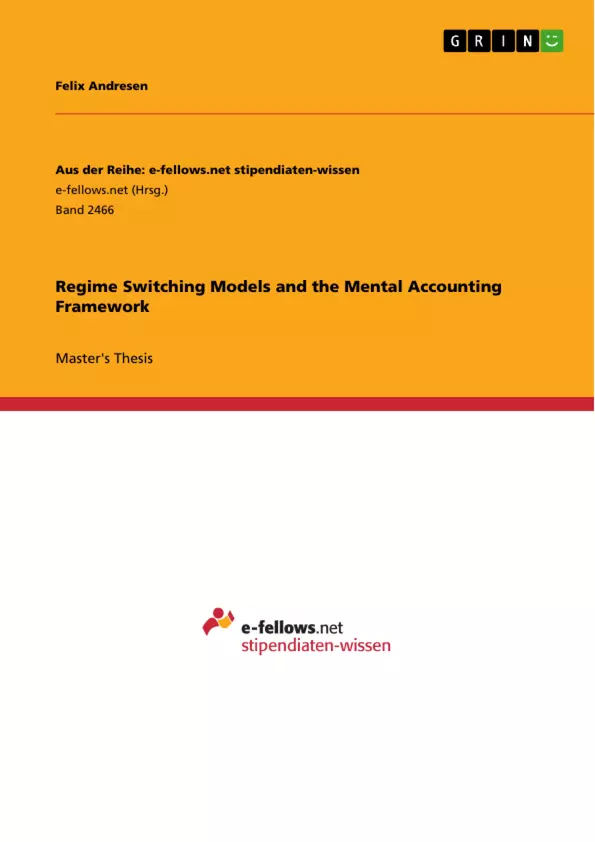The main goal of this thesis is to combine all of these concepts into a unified framework, evaluate its feasibility and performance, and to perform an analysis of the most common pitfalls and practical considerations. This unified framework uses both the MVPT and MA approach for asset allocation, but at the same time allows for dynamic and fat-tailed distributions of asset returns. It is implemented in approximately 1200 lines of efficient MATLAB code, which is publicly available at https://github.com/FelixAndresen/RSMentalAccounting. The application is programmed in a way that it is readily expandable to a larger number of assets and other investment approaches. The framework is also independent on the choice of assets, which is why the choice of assets for the illustration of the thesis findings was based on the availability of data.
The thesis is structured as follows. Chapter 2 reviews the current literature and theoretical concepts. More specifically, Chapter 2.1 introduces the Mental Accounting framework and the connections and differences to Markowitz’s Mean Variance Portfolio Theory. In Chapter 2.2 the most important concepts of dynamic investment management and stochastic programming are introduced. Chapter 2.3 discusses the regime switching models used to generate scenarios for the stochastic programming approach and the important topic of model selection. Chapter 2.4 gives an overview of Gaussian Mixture Models which present a tool to create the expected distribution used to optimize the asset allocation. In Chapter 3 all the pieces from the theoretical parts are brought together to formulate the dynamic programming models and the hypotheses to be tested in the thesis. The market data used to carry out the analysis is discussed in Chapter 4, as well as some necessary methodology on how to calculate, aggregate and interpret asset returns.
Chapter 5 presents exemplary and illustrative results, and discusses the strengths and weaknesses of the MVPT and MA investment approaches. The thesis closes with a summary and conclusion in Chapter 6.
Inhaltsverzeichnis (Table of Contents)
- Introduction
- Literature Review
- The Mental Accounting Framework
- Markowitz's MVPT vs. MA framework.
- Mean-Variance Optimization of Mental Accounts
- Dynamic Investment Management
- Components of a Stochastic DP model
- Abstraction of the stochastic programming approach
- Scenario Generation
- Regime Switching and Markov Chain Models
- The Three Basic Problems for HMMs
- Components of a Hidden Markov Model
- Model Selection.
- Gaussian Mixture Models
- Definition of Gaussian Mixtures
- Gaussian Mixture Models in Stochastic Programming
- Moments of a Gaussian Mixture Distribution
- The Mental Accounting Framework
- Mental Accounting with Regime Switching
- Stochastic Programming Problem Formulation
- Objective Function
- Constraints
- Definition of Stages.
- Scenario Generation
- Decision Policy
- Backtesting
- Hypotheses
- Stochastic Programming Problem Formulation
- Market Data and Methodology
- Market Data
- Methodology
- Missing Data.
- Results
- HMM Calibration
- Model Selection.
- Analysis of the selected model
- Scenario Generation
- Asset Allocation.
- Backtesting.
- HMM Calibration
- Summary and Conclusion
Zielsetzung und Themenschwerpunkte (Objectives and Key Themes)
This Master thesis investigates the application of regime switching models to the mental accounting framework in portfolio optimization. The study aims to incorporate the dynamic nature of market conditions and investor behavior into asset allocation strategies.
- Mental Accounting Framework
- Regime Switching Models
- Dynamic Investment Management
- Stochastic Programming
- Backtesting and Performance Evaluation
Zusammenfassung der Kapitel (Chapter Summaries)
The thesis begins with a review of relevant literature on mental accounting and dynamic investment management, exploring the relationship between investor behavior and portfolio construction. It then introduces regime switching models, particularly Hidden Markov Models (HMMs), and Gaussian Mixture Models (GMMs), as tools for capturing market dynamics. The main chapters delve into the application of these models to the mental accounting framework, outlining the problem formulation, scenario generation, decision policy, and backtesting procedures. The final chapters present the results of the analysis, including model calibration, scenario generation, asset allocation strategies, and backtesting performance evaluations.
Schlüsselwörter (Keywords)
The thesis focuses on the intersection of behavioral finance, quantitative finance, and dynamic asset allocation. Key keywords include Mental Accounting, Regime Switching Models, Hidden Markov Models, Gaussian Mixture Models, Stochastic Programming, Portfolio Optimization, Backtesting, and Risk Management.
- Citation du texte
- Felix Andresen (Auteur), 2014, Regime Switching Models and the Mental Accounting Framework, Munich, GRIN Verlag, https://www.grin.com/document/369448



